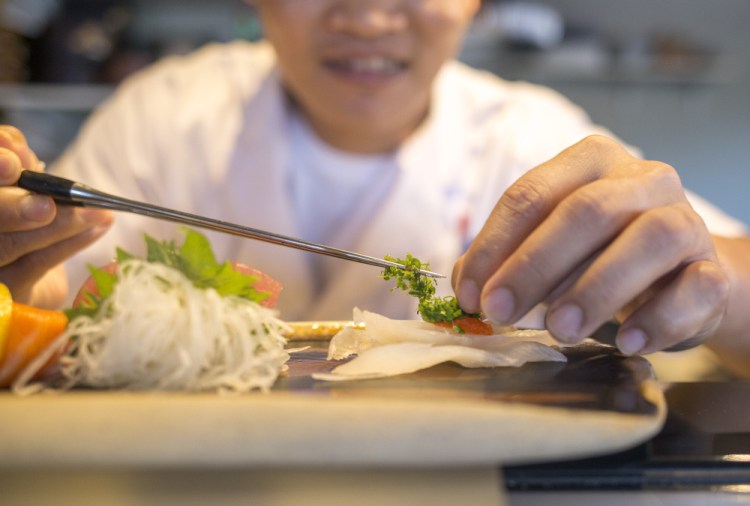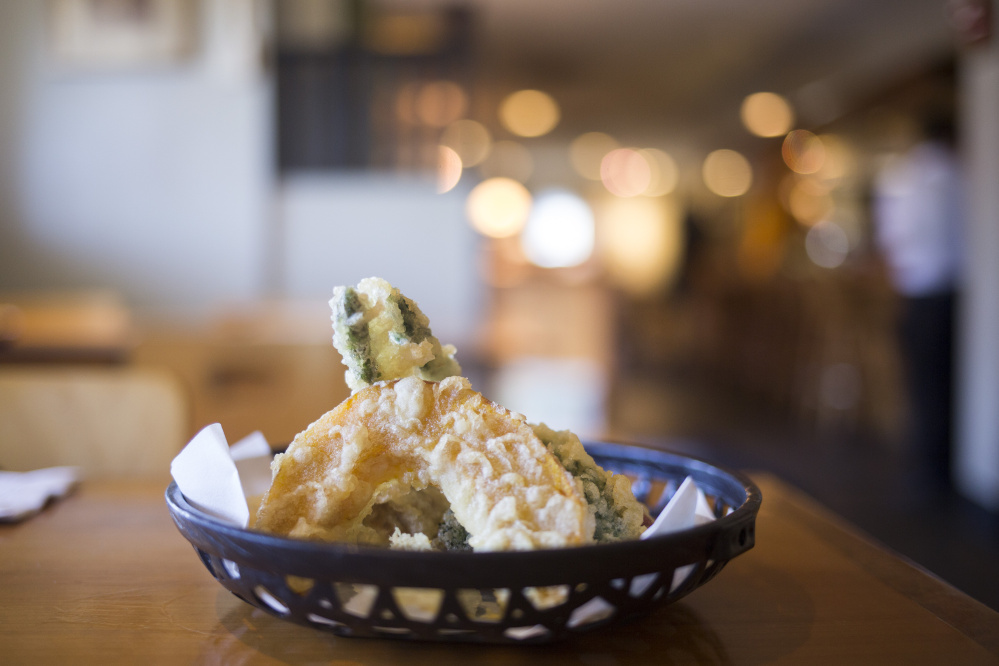Every time I think I’ve got Yosaku figured out, it confuses me all over again. It starts the minute I walk in to the Portland restaurant’s Tardis-like interior, which feels like an uncomfortable chimera of two different businesses, bolted together. Turn right and you’ll find an open sushi kitchen and Japanese seating with low tables set up on a raised lacquered-beam platform – very traditional. Head to your left though, and you’ll see what looks like a corporate dining room with a few wood-railed screens, lots of purely functional furniture, and a drab wall-to-wall carpet. Plus, when the weather is nice, there are another 40 to 50 seats on the open patio. With a capacity that, according to executive chef and owner Takahiro Sato, exceeds 150 people in the summer, Yosaku is an enormous restaurant.
Not to be outdone, the menu is equally super-sized, clocking in at an eye-popping 45 appetizers, plus more than 100 sushi and sashimi choices, as well as udon, soba, tempura, donburi (rice bowls) and grilled meals. “The restaurant is huge, and we need to fill it up every day so we don’t have to charge more. That means we serve many choices so we can get a variety of customers,” Sato said. A big menu can create big challenges, and this one – with enough dishes to support five or six separate restaurants, each with a distinct identity – is no exception.
One of the biggest is service. Staff, dressed in Kendo garments, seem frequently rushed and not especially well-trained. On one visit, our entrees showed up within a minute of our appetizers. On another, our empty dinner plates remained on the table after our dessert arrived. Servers also struggle to answer questions about dishes, but it’s hard to fault Yosaku’s staff for imperfect menu knowledge. Imagine showing up for your first week as a server and having to master the ingredients in roughly five dozen specialty sushi rolls. And that’s just one single page of the menu.
Still, unfamiliarity with the restaurant’s dishes has a sharp end, as I discovered when I was served a hot bowl of sliced beef udon ($14) on a tray next to a small wooden shaker. When I asked a passing server, she told us, “That’s the sauce for the noodles. I haven’t tried it, but I hear it’s really good.” I inverted the dispenser and discovered not a sauce inside, but shichi-mi togarashi: a hot pepper blend containing chili and sansho peppers, sesame seeds, ginger and several other spices. It’s lucky that very little came out, because the condiment lent the overly sweet broth a concussive punch.
Managing the vast menu also forces the restaurant to cut corners in places, as with its tart, vinaigrette-dressed ika sansai squid salad ($5.75), with thinly sliced mountain vegetables like fern, mushroom, bamboo and wood ear mushrooms. It’s a very good squid salad, but not one that Yosaku prepares itself. Rather, it comes as a pre-made frozen product and is thawed for service.
The kitchen also appears to skip steps, occasionally sending out dishes that don’t seem to have been tasted, like a hospital-food-bland avocado salad ($4.50), or an oily-tasting, double-crusted tempura matcha ice cream ($5) – a dessert highlighted along with the tempura cheesecake in our 3.5-star review from 2006 as “a real indulgence.”
On the other hand, when Yosaku’s head chef Masahiro Matsuyama (who is in charge of all non-seafood dishes) succeeds, he does so with real flair. You get a sense of his skills from the vegetable tempura ($4), an appetizer that features slices of sweet potato, squash, yam and stalks of asparagus, all battered with an ultra-light rice flour coating. Best of the bunch was a single broccoli floret that, when dipped into a pale, dashi-based sauce, tasted wild, complex and full of umami – a million miles away from crudite.
His kinpira gobo ($4), a slow-braised burdock root salad with slices of carrot, was a homey version of a classic Japanese starter, and a very solid one, if perhaps a little too sweet. Here, in contrast to the squid salad, the rough, rustic slices of burdock root are a giveaway that it is fresh and made in-house, and not the pre-prepared machine-sliced matchsticks that you’ll see elsewhere. The crunch and fibrous texture of the dish make it a great starter before a sushi meal.
But before we get to sushi, let’s talk about rice. Preparing outstanding sushi rice is equal parts art and science. It requires close attention to every step as the chef rinses, boils, seasons with vinegar and cools the rice – but not too much, as it must be kept at approximately body temperature until it is served. Jiro Ono, the world-renowned sushi chef profiled in “Jiro Dreams of Sushi,” famously trains his apprentices by having them do nothing but prepare rice for two years.
At Yosaku, rice is an issue. It’s close to being right, but every time I have visited, the grains have been just a little tough and undercooked, and on occasion, a bit too vinegary. These aren’t ruinous problems, but they are enough to make the experience of eating a pure slice of raw fish a little less extraordinary.
You can really spot the faults in the rice when eating simple nigiri, like the maguro tuna, salmon, or the marvelous, buttery yellowtail that come with the Acadia sushi set meal ($22). All three slices of fish were a delight, but the rice was the weak point. Fortunately, the Acadia meal also came with a decent Kewpie mayonnaise-based clam salad and a long sushi roll made with Maine crab and slightly crunchy green tobiko (flying fish roe), all topped with thin slices of crimson tuna and raw, glossy sweet shrimp (botan ebi). And perhaps the best part: the botan ebi heads that have been seasoned and deep-fried – these are not just a garnish! Despite their extra-crunchy texture, they are edible and require that you take your time to chew them slowly, avoiding pointy bits. They are absolutely worth the effort.
I also sampled two sashimi: the unagi (eel, $5.50) and the saba (mackerel, $4). Mackerel sashimi is almost always served lightly marinated, both to cut the strong fishy flavor, as well as to help cure the outside of the flesh to keep it from spoiling. The saba was respectable, but hampered by a too-acidic marinade. For the unagi, the kitchen grills strips of freshwater eel, slathering the meat with a rich and funky basting sauce, made by simmering soy, sugar, sake and the eel heads for several hours. Sato told me that their sauce actually takes two full days to make. Such careful attention to process and detail pays off, because Yosaku’s unagi is divine.

Brian and Amy Chamberlain of Gorham, N.H., enjoy the Japanese-style pond and greenery on the patio. The couple used to frequent Yosaku when they lived in Portland.
When you consider that Sato has been in the seafood business for more than 40 years, it should come as no shock that seafood dishes are the strongest elements of his restaurant’s extended dance remix of a menu. “I’ve always been interested in seafood. It’s why I came to Maine,” he said. But when you ask Sato, now 71 and thinking about what he calls his “secret final dreams,” he won’t tell you about lobsters or fish. Instead, it’s buckwheat. “Northern Maine is a perfect spot to grow buckwheat for soba noodles. We are harvesting now and going to ship samples to Japan. Maybe soon you’ll see Japanese soba made from Maine flour,” he said. What his new buckwheat business means for Yosaku remains to be seen, but it’s a safe bet that we can count on one thing: It’ll be a surprise to us all.
Andrew Ross has written about food in the United Kingdom and in New York, where he co-founded NYCnosh, a food website. He and his work have been featured on Martha Stewart Living Radio and in The New York Times. He is an Internet researcher and higher education consultant. Contact him at andrewross.maine@gmail.com or on Twitter @AndrewRossME.
Send questions/comments to the editors.




Success. Please wait for the page to reload. If the page does not reload within 5 seconds, please refresh the page.
Enter your email and password to access comments.
Hi, to comment on stories you must . This profile is in addition to your subscription and website login.
Already have a commenting profile? .
Invalid username/password.
Please check your email to confirm and complete your registration.
Only subscribers are eligible to post comments. Please subscribe or login first for digital access. Here’s why.
Use the form below to reset your password. When you've submitted your account email, we will send an email with a reset code.